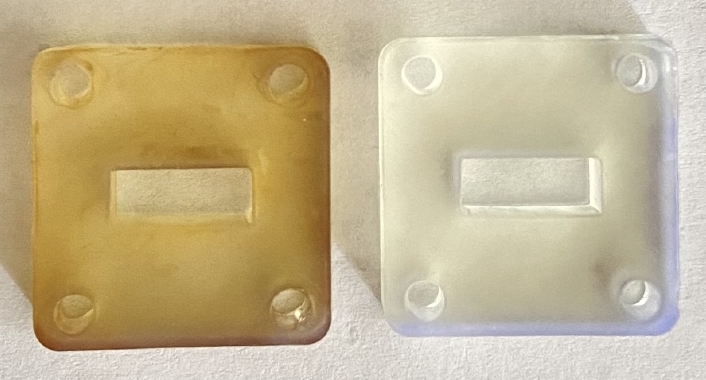Comments
-
Plating on 3D printed ABS resins?So, quick update on this:
We figured out two things the past week which improved the surface adhesion:
- Adding a surfactant: we just mixed in a bit of dishwashing liquid, and
- Adding an oxidizer: we added a bit of household bleach (3% sodium hypochlorite)
Much smoother silver finish, with much better adhesion.
t -
Plating on 3D printed ABS resins?Thanks for the advice!
These SLA resin printed parts are... tricky to plate. As you rightly mentioned, smoothness hampers adhesion for e.g. a palladium colloid needed for electroless plating (or the seed layer for electroplating), so the guys that plate injection molded chrome plated auto parts use chromic acid, hydrochloric acid, potassium permanganate, or any number of other strong oxidizers. Sandblasting will work as well, but not inside complex waveguide assemblies.
Unlike (from what we could gather) most injection molded parts, these SLA parts are porous... not as much as FDM parts, but enough to leave enough residual material that risks contaminating subsequent plating baths.

The other problem is, of course, that students (specifically EE students) and strong oxidizers don't mix well either.
What we really want is a way to get copper on the parts (including inside the waveguide parts) that is cheap, safe, does not require special equipment, and won't peel if you look at it funny. The Tollens' process is cheap(ish) and safe(ish), but the process recipe is still a bit cumbersome and the resilience leaves much to be desired. -
Plating on 3D printed ABS resins?So, after the usual trials and tribulations, the paper is now *finally* out, where we describe the process.
Downloadable version here:
https://www.researchgate.net/publication/368909379_SLA_Printed_K-Band_Waveguide_Components_using_Tollens_Reaction_Silver_Plating
What we found is that slowing down the reaction by cooling it gives you a much better finish, and using multiple plating rounds really helps.
It's still a frail metallization approach, however, and easily rubs off with a few not-so-vigorous thumb swipes; fine for lab prototyping, but you'll need plating or some other coating to use it industrially. -
Plating on 3D printed ABS resins?So, quick update on this:
After almost a year of trial and error, we finally figured out that a few rounds of Tollens' reagent (https://en.wikipedia.org/wiki/Tollens%27_reagent) works like a charm... much more even finish than trying to electroplate copper, and IL (@ K-band) only marginally below metrology grade waveguide.
Paper will be submitted to IEEE CPMT soon; will keep everyone posted. -
Plating on 3D printed ABS resins?Thanks for the suggestions! Spraypainting might be bit tricky inside the waveguide, but we'll certainly try the acetone vapor!
t -
Is it worth using a choked WG flange for lab testing?That would make a lot of sense; thanks for that! All the more reason for us to omit it from our design (K-band satellite transceiver won't output anywhere near 5 kW).
-
Is it worth using a choked WG flange for lab testing?Sounds promising! An no significant loss across the flange connection?
Tinus Stander

Start FollowingSend a Message
- Terms of Service
- Useful Hints and Tips
- Sign In
- © 2026 Microwaves 101 Discussion Board